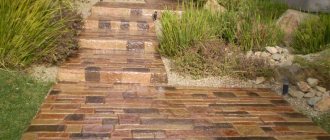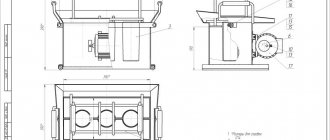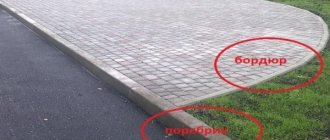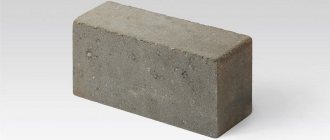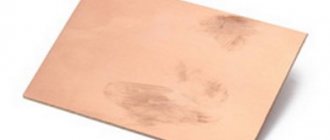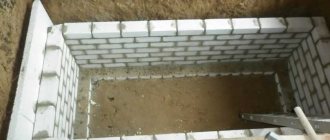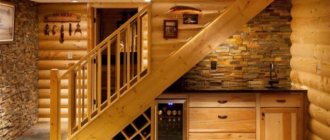Features of concrete flower beds
Concrete flower beds are used almost everywhere; there are no restrictions on their use. They are made from high-strength materials and placed on objects for various purposes. Here it is important to be able to choose the right design solution so that the concrete structure has the most advantageous appearance and is an additional decorative element.
Outdoor concrete flower beds are presented in a wide variety of variations; they can differ in both shape and size. They are used as a kind of space delimiter, to create an accent against the background of a green carpet - lawn, flower crops. Concrete flower beds are also chosen for landscaping because they can be painted multiple times. Their surface can be either smooth or embossed. Installation of a cement flower bed can be done in several ways:
- To the surface. Due to its serious weight, a concrete flower bed is able to occupy a strong position even without additional supports or fastenings.
- By digging into the ground. Thanks to this technique, you can create an original multi-level flowerbed, or adjust its dimensions to the required size.
- By means of formwork equipment in the ground. This design can have high sides or go completely into the ground, allowing you to build diverse flower beds. Cement mortar is poured into this formwork and, after drying, painted if necessary. Ornamental crops in this case can also be of different sizes and in different quantities. As an option, you can make a flowerbed in the form of a specific design or pattern.
Advantages
Among the positive characteristics of concrete flower beds are:
- high degree of resistance to negative environmental factors (excessive humidity, precipitation);
- excellent strength qualities;
- long service life (almost 50 years);
- high aesthetic qualities;
- saving yard space when using vertical concrete compositions;
- use as a sustainable barrier;
- the possibility of creating multi-level flower beds;
- easy to paint;
- possibility of making it yourself;
- ease of care.
Important! When decorating a concrete flower garden, you can use small pebbles, glass mosaics, and paints and varnishes. To create an ornament, just use a sharp tool.
Flaws
The disadvantages of cement flower beds include:
- large size;
- large mass;
- the need for decorative processing;
- difficulty in moving to another place.
If there is a need to make an elegant flower garden, then instead of cement it is recommended to use more suitable materials, for example, gypsum.
Ready-made concrete flower beds
The market offers ready-made concrete flower beds that can either be dug into the ground or installed on a flat surface. There are rectangular concrete flower beds, as well as products in the shape of a vase, bowl, and various geometric shapes. A basket flowerbed made of concrete looks especially interesting near the house, on garden paths. A cement flower bed should not be buried in the ground; it is best to paint a concrete flower bed.
Ready-made concrete forms no longer require labor for their production and are completely suitable for garden design. They are manufactured according to technology, have a sufficient level of resistance to temperature changes, precipitation, and are easy to treat with disinfectants, which are used in the fall, when the plants fade.
One of the varieties of cement flower gardens is decorative concrete blocks. They are ideal for arranging flower beds, which are intended for the construction of supporting walls using the dry laying method. There are blocks with special holes through which connecting rods are pulled. There are also models that need to be compacted. The undeniable advantage of such a building material as concrete is its ease of use. Such products have smooth edges, and assembly of the structure does not cause any particular difficulties.
To create a flower garden on a personal plot, any materials that are resistant to adverse environmental factors, but with drainage, are quite suitable. The most common option for constructing flower beds is concrete drainage pipes, which are installed in a vertical position. They look worthy in solo performance, where each is planted with a decorative bush or tree, and in a group composition with perennial plants.
Wall? No, flowerbed!
Your wall can easily turn into a flower bed if you use hollow blocks to build it. The elements are easily installed on top of each other, the voids in the lower rows are filled with sand, in the upper tier - with fertile soil. This design does not require a binder solution and is held in place by its own weight.
Try using regular building blocks. They are not so beautiful, but you can also plant flowers in their cavity and finally line it with artificial stone.
| 1. Place the stones on the drainage layer, level them horizontally and fill them with sand or soil to the brim. | |
| 2. Start the second row with half a stone. Then lay out the whole ones. Fill the voids with sand. | |
| 3. Fill the last layer of stones with good floral soil for plants. | |
| 4. Plant flowers. That's it, the flowerbed is ready. |
Almost all the plants found in rock gardens grow in the seams of dry masonry walls, for example, tenacious, juvenile, and sedum. Water the planted plants daily at first so that they take root well.
These articles may also be of interest to you:
- Strengthening slopes with stones. Decorative and retaining walls
- Installation of facade blocks
- Original flower beds made from old boots and shoes
- Design and interior of bathrooms with nature views
Forms for pouring concrete flower beds
To make a round flowerbed from concrete or any other shape, you can use ready-made molds or make them yourself.
Purchased forms
Molds made of plastic and silicone are available for sale; they are easy to use and have a wide range. To make a concrete flower bed, it is enough to assemble a mold, lubricate it with oil for easier removal of the product, and fill it with cement mortar. After two days, the concrete mass should harden and the form can be removed. But given the high cost of such products, it is more advisable to purchase them if not one, but a large number of flowerpots are made.
Forms from improvised means
This solution is budget-friendly; any plastic container can be used to make flower beds. They are also lubricated inside with oil, a bucket of stones is placed in the center for better stability, and the space around it is filled with concrete. The cement mortar hardens after 48 hours, after which both the bucket and the mold are removed. You can decorate a concrete flowerbed with mosaics, paint it in a suitable color, or leave it as is.
You can also make flower beds with your own hands from fabric and cement. The manufacturing process is quite simple: the fabric is immersed in concrete for impregnation and then hung on a bucket. A flowerbed made of cement and rags can have a more original look if the edges are slightly bent when the mortar begins to set. If you use burlap as a fabric for a concrete flower bed, you can achieve an interesting topography.
Photos of a flower bed made of cement and fabric are presented below.
How to make a concrete flowerbed with your own hands: photos, steps, how to paint it
A do-it-yourself cement flower bed can be effectively used for arranging a local area, recreation area, or garden. Thanks to such reliable structures, you can improve your landscape design and create a comfortable environment. It is better to install concrete flower beds in areas with a flat surface, on tiles, asphalt areas. Such flowerpots gained their popularity due to their long service life and high decorative qualities. To make concrete flower beds with your own hands, you need to consider in more detail the process of their manufacture and follow the step-by-step instructions.
How to make a concrete flowerbed with your own hands
To achieve the desired result, it is necessary to prepare more thoroughly for the manufacturing process.
Layout and preparation of materials
Since a concrete flower bed is installed for more than one year, the choice of its location and shape should be approached with all responsibility. The first step is to decide where the structure for growing perennial crops will be located. In most cases, they are identified at the entrance to a personal plot, yard, as well as in the front garden, at the intersection of garden paths.
Regardless of the size of the concrete flower garden, it will become a real decoration of the site, its highlight. A flower bed with annual and perennial plants looks most presentable and noble. To give the flowerpot a clearer outline, it is recommended to plant flowers not very densely in the center, and closer together at the edges.
Important! For normal growth and development of ornamental crops, it is better to choose a place in a well-lit area protected from draft winds.
It is at the planning stage of a flower garden that issues such as appearance at different times of the year, at the flowering stage and during the wilting period, are decided. For greater effectiveness, plants should be selected so that they please the eye both in early spring, when the first shoots appear, and during the period of lush flowering. It is necessary to plan so that the concrete flowerbed has a rather attractive appearance even in winter.
For ease of design, it is recommended to draw a sketch of the future structure on paper, which clearly displays the size, shape, and number of plants. To make concrete flowerpots and flower beds of various configurations, you will need the following materials:
- crushed stone;
- sand;
- cement;
- water;
- special additives.
Portland cement is used as a binding component, consisting of clinker of the same name, slag, gypsum, ash, pozzolans and other mineral inclusions. There are other varieties: expanded clay concrete, where expanded clay is used instead of crushed stone, sand concrete, where sand of different fractions is used. Not only drinking water, but also ground and technical water is suitable for preparing the working solution.
Land works
The next stage of making a flowerbed with your own hands from concrete is transferring the outlines of the flower bed to the surface of the earth. First you need to make external markings, then, stepping 20 cm inward from the edges, draw a line defining the internal volume of the flower bed. For greater stability, it is recommended to maintain a wall thickness of 15 cm. The depth of the trench should be 15 cm, the bottom and sides should be well compacted.
Frame making
In the corners or in places of curves, it is necessary to drive pegs, the length of which is 30 cm, and attach them with screws, bending sheets of chipboard or fiberboard along the contour of the future flower bed. If you need to make a wavy design, then it is optimal to use plastic. To fix the frame from the outside, spacers are provided.
Preparation of the solution
To obtain a high-quality concrete mass, you should adhere to a certain ratio of the components used:
- sand (4 parts);
- cement (1 part);
- water (the consistency should be creamy);
- crushed stone (4 parts).
After mixing all the components, to maintain the fluidity of the solution, you need to add more water if necessary.
Pouring concrete
It is recommended to pour concrete flower beds at a temperature not lower than -5 °C, and you should not do this in very damp weather. If pouring is done in the hot season, then the soil is pre-moistened, otherwise the moisture from the solution will go into the dry soil. The finished concrete mass is carefully and evenly poured into the prepared frame. Remove the formwork after the solution has completely dried. Finally, the flowerbed is filled with fertile soil mixture and the plants are planted.
Flowerbed made of concrete
Cement is a fairly economical material, and due to the plasticity of the concrete solution, any shape can be created from it. But by itself, concrete has a very unsightly gray color, and if you are not planning to create a yard in the style of post-apocalyptic urbanization, then it is better to use paints when mixing the solution.
Important nuances
It is the shape and color of the future vase that you should pay attention to. The appearance of the flowerbed should not compete with the flowers planted in it.
For this reason:
- When finishing concrete pots, you should use soft shades of colors.
- Painted pots in their ornament can combine the colors of the plants planned to be planted in them.
- If the flower bed in the flower bed is planned to change depending on the season, neutral colors should be used when decorating.
On a note! Consider the installation space of the flower bed. A large wide vase in a small area will add inconvenience, and small pots on a wide terrace can become visually lost.
In addition to the color palette, you should consider some of the physical features of the pot. Water should not stagnate inside the pots - this will have a detrimental effect on both the plants and the concrete walls of the vase.
To do this, it is necessary to make technical holes in the bottom of the flowerpot to drain water. They can be laid at the stage of pouring the mold, if the concrete vase is made by hand, or drilled into a ready-made product.
Another disadvantage of concrete is its high porosity. A pot made of sand and cement will not last long.
In order for outdoor concrete flower pots to bring joy for many years, water-repellent and frost-resistant additives should be used when mixing the solution. Detailed instructions for using such additives are always written on the original packaging.
Use complex additives in the solution that will improve several properties of the finished concrete at once
Materials for the solution
If you decide to create a concrete masterpiece yourself, then you need to prepare the material for the vase and the tools and materials for the formwork in advance. The solution for a concrete flower bed is mixed in a standard proportion: 1 part cement to 3 parts sifted fine sand. In addition, you should stock up on dye.
In a concrete vase painted in the mass, the following can be used as a dye:
| Dye | The resulting effect | Photo |
| Marble chips | The surface of the concrete flower bed will be textured. Depending on the crumb fraction, the degree of color uniformity will vary. |
|
| Coloring pigments (powder compositions) | Mixed concrete will not change color over time. |
|
| Oil paint | When adding oil paint to a solution, do not mix it thoroughly (that is, first mix the solution and then pour in the pigment). The paint will not dissolve in concrete and will give a marble effect when poured. |
|
Formwork tools
Any durable material can be used as formwork panels. Ideally, it should not absorb water. But if you can create the required shape only using cardboard, then ordinary plastic film can be laid as a water barrier. At the same time, large flower beds can be poured into a hole dug in the ground. The main thing is to strictly define the boundaries.
For small pots, you can use plastic paint buckets or 19 and 5 liter water bottles. The photo below is an example of making a small concrete vase with formwork from plastic paint buckets.
The photo shows step-by-step instructions for making a concrete flowerpot using plastic buckets
Manufacturing technology
The process of making a concrete flower bed is quite simple:
- The outer wall of the formwork is formed in any convenient way.
- A layer of waterproofing is laid, if necessary.
- A point is arranged for a technological hole in two bowls.
- The bowl, the inner border of the formwork, is fixed.
- The solution is poured, tapped or slightly shaken to expel air bubbles.
- Open areas of the solution are covered with plastic film to prevent rapid evaporation.
On a note! The thickness of the wall of the flowerpot depends on the size of the concrete flowerbed planned for production. But it is not recommended to make a concrete partition less than 3 cm. If you are not sure of the strength of the wall, use fiber reinforcement for the solution.
After pouring, the solution must be given time to set. The first seizure will occur after a day or three. In a week or 10 days, the formwork can be removed.
After removing the formwork, the product must be refined, removing all sharp corners and unnecessary roughness
The walls of the concrete bowl will still be very “soft”, which will allow you to get rid of some unevenness or round the upper edges of the bowl. The video in this article will help you get acquainted with the technology of making a concrete flowerbed with your own hands.
Making a flower bed made of cement
After the square concrete flower bed is made, it is beautifully decorated. There are several effective ways.
Painting
This method is easy to perform; it uses a colorful composition for concrete and stone for outdoor work. To paint a concrete flowerbed in the yard according to all the rules, the surface must be cleaned of dust particles and treated with a deep penetration primer 2 times. It is noteworthy that every time the decorative crops in the flower garden change, the color of the flower bed can also be changed.
Below is a photo of painted concrete flower beds.
Bas-relief
To create an original pattern on the surface of a flower garden, it is effective to take leaves from burdock or other beautiful plants that are distinguished by pronounced hard veins on the plates. It is enough to attach the leaves to the inside of the outer part of the frame, and fill the space in it with concrete mass. After removing the formwork, the sheet plates are removed using water.
Important! If you want to make the pattern of the sheet clearer and more effective, the veins need to be colored using color tinting.
Mosaic
To decorate a flower garden with mosaic elements, you need to use quick-setting construction adhesive. Suitable for these purposes are shells of various sizes, sea pebbles, fragments of tiles and any other materials with high resistance to water. The process of decorating a flower bed with a mosaic involves the following steps:
- On a sheet of paper, draw a pattern that you want to see in the flower garden. The main thing here is to take into account the direction of the surface of the flowerpot, especially for a spherical design.
- Apply a design to the surface of the bowl using chalk.
- The mosaic is first glued along the contour, and then the internal space is filled.
- At the end of the work, the pattern is opened with varnish.
How to make a flowerbed from cement with your own hands
To successfully make concrete flower beds with your own hands, you need to adhere to the proportions when preparing the working solution, and correctly build the frame and pour it.
Layout
Before you make a concrete flowerbed with your own hands, you need to think carefully about where it will be placed. To install an original flower bed with perennial plants, it is recommended to choose places at the entrance to the plot, in the garden, near paths.
Multi-tiered concrete structures can effectively decorate any area
Planning involves choosing a site, designing a flower garden, and selecting plants. The flowerbed should have a presentable appearance from spring to late autumn. To make it easier to navigate when making a concrete structure, it is recommended to make a sketch on a sheet of paper, which will include the dimensions of the flowerbed, the configuration, and the number of plants.
Tools
To make concrete flower beds with your own hands, you will need a set consisting of the following materials and tools:
- cement;
- fine crushed stone;
- sand;
- plasticizers;
- coloring pigment;
- polyethylene;
- high density cardboard;
- lumber for collecting formwork;
- scotch;
- shovel;
- scissors.
Concrete trees
Sculpted concrete is used to make artificial trees. Such products are used to decorate rock compositions, suspension bridges, and unusual benches in parks. Often such decorative elements - sculptures - are found at the entrance to a cafe, recreation area, or children's playground. Basically, concrete trees are empty inside; they can be either in the form of a full-fledged plant or in the form of its individual parts: a stump, root system, branches.
Choosing colors for concrete flower beds
An excellent solution in choosing plants for decorating concrete flower beds would be New Zealand flax, hosta. Ornamental crops with unusual leaf mass fit harmoniously into the landscape design. Preference should be given to weed-resistant perennials and grasses. Bright pelargoniums, rhododendrons, and fuchsias look very beautiful against a green background.
When choosing decorative crops, you need to focus on the spectacular appearance of the flower bed throughout the year. In addition, to create a real decoration for the garden, you need to place them correctly. It is better to plant tall specimens in the background in a concrete flowerbed, and short ones in the foreground.
It is recommended to plant plants with the same soil and care requirements in the same flower garden. Playing with contrast can be advantageous, so it is worth considering compositions that contain flowers with yellow and blue colors. But it is quite acceptable to use plants of the same color to create concrete flower beds. White flowers look beautiful in combination with plants that have silvery foliage.
